| |
Regular Imperial German Awards
German colonial and
overseas troops were eligible for the same awards as troops
in the regular German army. Members of
Imperial units were usually awarded Prussian medals although
other German states also awarded medals to their servicemen
in the colonies. |
|
| |
|
Prussian Pour-Le-Mérite |
|
| |
|
Prussian Iron Cross |
|
| |
|
Other Prussian Awards |
|
| |
|
Non-Prussian Awards |
|
| |
|
Post 1918
Veterans Awards |
|
| |
|
|
|
| |
Medals for Colonial and Overseas Service
There were three
specific campaign medals awarded by the German Empire for
colonial and overseas campaigns. The China and South West Africa
Campaign Medals were awarded to German combatant and
non-combatant veterans of the Boxer and Herero/Nama Rebellions
respectively. The Colonial Service Medal was awarded to German
combatant veterans of other colonial campaigns. African and
Asian other ranks in the German colonial forces were not awarded
campaign medals. There were two other medals
awarded only to commemorate overseas expeditions- the Jerusalem Cross
and the Mecklenburg-Schwerin Africa Medal. |
|
| |
|
China Campaign Medal |
|
| |
|
South West Africa
Campaign Medal |
|
| |
|
Colonial Service Medal |
|
| |
|
Other Awards Exclusively for Overseas Service |
|
| |
|
|
|
| |
Foreign Awards
German servicemen overseas
could earn foreign medals while serving alongside allied armies in
either peace or wartime. The most numerous foreign medals seen in
period photographs are the Ottoman Turkish Medals awarded to their
German allies in the First World War. |
|
| |
|
Ottoman Turkish Awards |
|
| |
|
Other Foreign Awards |
|
| |
|
|
|
Methods of Wearing Medals
Senior Awards
Medals at the Throat
Some very high ranking awards, such as the Prussian
Pour-le-Mérite, Grand Cross of the Iron Cross and Order of
the Red Eagle first and second classes, were worn at the
throat on a ribbon around the neck. They did not then appear
on a recipients medal bar.
Badges on the Lower Left
Breast
Some high ranking medals, such as the Prussian Iron Cross,
first class (and some equivalent German state medals such as
the Mecklenburg-Schwerin Military Merit Cross, first class)
and some foreign awards such as the Ottoman War Medal (or
Gallipoli Star) and the Georgian Order of St Tamara were
usually worn as a badge without ribbon on the lower left
breast or left pocket. Again, they did not then appear on a
recipients medal bar.
Medal Ribbons in the
Buttonhole
Some medals, usually wartime distinction or bravery awards
(such as the Iron Cross Second Class, the Bavarian Military
Order of Max Joseph and the Ottoman War Medal or Gallipoli
Star) could be worn as a ribbon in the second button hole
from the top of the tunic. This was usually done with the
ribbon alone although some photographs show the medal or
combatants swords also worn in this position. Occasional
period photographs show two medal ribbons worn in the same
position. Again, medals worn this way did not appear again
on a recipients medal bar.
Medals Hung on the Upper
Left Breast
Most medals were worn simply as the medal itself hung from
its ribbon on the upper left breast, above the breast
pocket. Ribbons could be folded in several different ways-
straight down (most common on individual awards), folded
into a trapezoid shape (as was common prior to the First
World War in Prussia and the North German states), folded to
double width (South German style), or in the case of
Austria-Hungary, folded into a point-down triangle.
Sometimes full size folded ribbons were worn without the
medal itself.
Miniature medal bars were
also worn. These simply had the ribbon alone sometimes with
the addition of miniature campaign clasps or crossed swords
where applicable. Post-war veterans sometimes wore their
medals in the from of buttonhole miniature bow tie badges.
Order of Seniority on Medal Bars
When more than one
medal was worn on the breast (either full size or miniature
versions) they were usually worn as a fixed medal bar. The
medals were worn in order of seniority from the wearer's
right (next to his buttons) to his left (next to his
sleeve).
German Imperial Forces
(such as the Schutztruppe, Navy, Marine Infantry and
East Asian Occupation Brigade) wore their medals in the order of seniority
as regulated for the Prussian army. These regulations
did however change from time to time, were sometimes
(deliberately or accidentally) ignored and were
different for the armies of some other German states.
This makes the order of seniority an extremely complex
topic. In a very simplified form
the Order of Seniority was-
Prussian Iron Cross
Second Class
As the Pour-Le-Mérite was worn at the throat and the
Iron Cross First Class was worn on the breast, the most
senior medal on a bar was the Prussian Iron Cross First
Class and when awarded was almost always seen at the
front of a bar.
Senior Prussian
Combatant Orders
The Iron Cross was followed in order of seniority by
the Knight of the Royal House of Hohenzollern with swords,
Order of the Red Eagle (third and fourth class- higher
awards were on the breast or at the throat) with
swords and the Crown Order with swords. The "with
swords" for each award meant that it was awarded for
active service rather than "without swords" medals
awarded for non-combatant service which ranked lower in
order of seniority.
Other Prussian Medals
Other Prussian awards were worn next such as Warrior's
Merit Medal, the Military Honour Award, the
Life Saving Medal and Red Cross Service awards. Lower classes
and non-combatant awards of the Red Eagle and Crown
Medal were also worn in this section.
Prussian Long Service Awards
The long service awards for NCOs and officers were
worn next from 1913 onwards. Prior to then they had been worn as
clasps lower on the left breast.
Campaign Medals
This included awards from the Franco-Prussian and the Austro-Prussian Wars as well as for overseas
campaigns such as the China, South West Africa and the Colonial
Service Medals. From 1935 the regulations changed and
veterans then wore these campaign medals ahead of their
long service awards.
Awards from Other
German States
After all Prussian awards came awards from other
German states (such as Bavaria, Saxony and Württemberg), even if they technically out-ranked the
Prussian medals worn. This order only applied if the
wearer was in Prussian or Imperial (Navy, Marine
Infantry, Schutztruppe or East Asian Occupation Brigade)
service. If the wearer was later in the service of their
home states service or retired, then their home states
medals could be worn ahead of their Prussian or Imperial
awards.
Awards from Kingdoms (such as Bavaria and
Saxony) were worn before awards from Grand Duchies (such
as Baden or Hessen), which in turn were worn before bars
from Duchies, Principalities and smaller states.
Awards from Foreign
Countries
After all German awards came awards from countries
outside of Germany, even if they technically out-ranked the
German medals worn. Foreign medals were worn in alphabetical
order (with German spelling of course) of the country
which awarded them. An exception sometimes seen was when medals
were awarded while in a country's
service were worn ahead of medals awarded by a country
whose service they had not been in.
For example, an
East African askari who had previously served in the
Egyptian army and been awarded the Egyptian Khedive's
Star would wear it behind any German medals when he was
in German service yet ahead of the British Egypt medal
which he might also have been awarded although he had
never been directly in British service. In this case
Egypt ("Ägypten")
would come ahead of Great Britain ("Großbritannien")
alphabetically as well.
Again exceptions
did occur among veterans and some surviving German medal
bars show foreign medals worn ahead of junior German
awards.
Exceptions to the Order of
Seniority
The Other German State
Armies
The non-Prussian Kingdoms of Germany (Bavaria,
Saxony and Württemberg) and some of the smaller states (for
example the Grand Duchy of Mecklenburg-Schwerin) had their own
regulations for orders of seniority. They were usually
quite similar to the Prussian system described above but
naturally gave precedence to their own medals over Prussian ones.
These state systems are
described in some detail at Gentlemen's
Military Interest Club,
(a small membership fee is required for access to some parts
of the GMIC).
When in imperial service (such as in the
Imperial
Navy, Marine Infantry, Schutztruppe and East Asian
Occupation Brigade) Prussian order of seniority was correct,
when in army service (such as the East Asian Expeditionary
Corps, the Pascha I and II Expeditions and the largely Bavarian Georgian
Legion) state orders of precedence were correct.
In the decades following
the First World War it was common to see Schutztruppe and
overseas veterans wearing their old uniforms but with
the order of their medals in their own state's order of
Seniority rather than adhering to old Prussian rules.
Later Changes to Order of
Seniority
As mentioned this is only
a simplified version of the Order of Seniority worn by
the Prussian Army (and therefore the overseas imperial
forces) prior to the First World War. Prussian
regulations changed before, during and also after the
war.
These later changes in 1935 included putting pre-1914
campaign medals ahead of long service awards, putting
medals awarded for the First World War ahead of any
awarded prior to the war and putting awards from
other German states (including Austria after 1938) on a
level with Prussian awards. The Prussian Iron Cross Second class
remained
superior to all other medals on a bar.
Reverse Order Bars
Sloped bars with the medals in reverse order of seniority ("Frackspange") were made for wear when the bar
was to follow a folded lapel, such as on tuxedoes for evening wear. Reversing the
seniority right to left made the most senior medal at the
top of the bar.
Unofficial
Exceptions
It should be noted that exceptions to these rules of
seniority were relatively common, even more so after the
fall of the Imperial Order in 1918. Some may simply have
done so by mistake, as the rules of seniority were
confusing, full of exceptions and liable to change from time
to time. Others may have promoted a medal on their bar due
to special pride in that particular award.
Recommended External Link - Mistakes in Medal Bar Wear at the Gentlemen's
Military Interest Club
More Notes on the Wearing of Medals
Multiple Awards of
the Same Medal
When the same medal was awarded more than once (in different
classes) to the same soldier, this was displayed in
different ways depending on the type of medal.
With some
medals a newer
award of a higher class replaced the pervious medal on the
bar (for example the Prussian Order of the Red Eagle, except
when a lower class medal had been awarded with a distinction
such as a crown or swords).
With other awards (such as the German Warriors Merit
Medal and the Bavarian Military Merit Order) more than one
medal of different classes could be worn either next to each
other.
Some medals were worn in different styles for
different classes and therefore could easily be worn
together (such as the the Prussian Iron Cross or the
Mecklenburg-Schwerin Military Merit Cross which could both
be worn as second class awards on the medal bar but only as
lower breast badges in the first class).
Non-Combatant Medals
Non-combatant medals were awarded to officials such as doctors,
paymasters and transport staff in the colonies but also for staff
officers based back in Germany yet involved in the command, supply
and organisation of troops in these conflicts were also eligible for
awards. The Ottoman War medal was also awarded to large numbers of
German officers of high rank or those with tenuous connections to
the conflict in the Middle East.
This
non-combatant distinction could be shown on medals in
different ways such as by having the colours of the medal
ribbon reversed (as on the Prussian Iron Cross and the
1914-18 Honour Cross), by not having the crossed swords of
the combatant medal (as on the Prussian Order of the Red
Eagle and the 1914-18 Honour Cross) or by having the medal
itself in steel rather than bronze (as on the China and
South West Africa Campaign Medals).
Receipt of Medals
It should also be remembered that most medals could only actually be
worn after they had been sent out by ship from Germany or when
the recipient returned to Germany after the campaign. The colonies
themselves did not usually have large supplies of medals for instant
decorations.
So for example, very few medals are seen worn by
officers of the East African Schutztruppe during the First World
War.
The Colonial Service Medal was only instituted in 1912 and was
therefore usually awarded retrospectively for campaigns dating back
to the previous decade or century.
Medals not
Worn
For practical reasons awards were often not worn in the
field, or were kept to miniature ribbon bars. Highly
decorated officers usually only wore their most senior or
relevant medals except on parade.
During the First World
War, servicemen who had previously been
decorated by Entente countries stopped wearing
their enemy medals.
Clasps
Campaign medals (such as the China Campaign Medal, the South West
Africa Campaign Medal and the Colonial Service Medal) could be worn
with one or more clasps on the ribbon bearing the
names of particular campaigns or battles on them. For example "Taku",
"Waterberg" and "Ponape 1910/11" for each of the
medals respectively.
These clasps were were privately purchased and
therefore even when applicable were not always worn. The
clasps were made of the same metal as the medals with which they were
awarded.
Medals for Africans in the Schutztruppe
African soldiers in the Schutztruppe and
Polizeitruppe were not eligible for Campaign Medals
or
Long Service Awards.
The German
Warriors Merit Medal (see
Prussian Medals) was instituted in several
classes especially to reward African soldiers.
In addition photographs show that medals such as
the Prussian Crown Medal, the Prussian Prussian
Military Honour Decoration and the
Mecklenburg-Schwerin Africa medal were also
sometimes awarded to Africans.
German Medals
Awarded to Foreigners
German medals could also be
awarded to foreign troops serving as allies in campaigns as was the
purpose of the Prussian Warriors Merit Medal and as commonly
happened the during the First World War with the Prussian Iron
Cross.
On two occasions German colonial campaign medals
were awarded to foreign troops. The South West African
Campaign Medal with a bar for "Kalahari 1907" was awarded to members
of the South African Cape Mounted Police and Cape Mounted Riflemen
who had assisted the Schutztruppe by tracking down and killing Jacob Marenga, when he and his Nama warriors evaded German capture by
entering Cape Colony. Their commanding officer, Major Elliot also
received the Prussian Crown Order, Second Class.
Similarly the South West
African Campaign Medal with a bar for "Kalahari 1908" was awarded to
members of the British Bechuanaland Protectorate Police Force for
their help in tracking down Simon Koper, when he and his Nama
warriors evaded German capture by entering Bechuanaland.
Recommended Reading - "German Medals, British Soldiers and the Kalahari
Desert" by Gordon McGregor
Recommended
External Link - The South African Military History
Society
During the Boxer
Rebellion the armies of the Eight Nation Alliance occasionally awarded
medals to each others soldiers. German medals were awarded to
officers and men of other allied armies and navies. For example Captain
John Jellicoe of the British Royal Navy
received the Prussian Order of the Red Eagle, second class with
swords for his actions in the
Boxer Rebellion.
Sources and
Further Reading
The subject of Imperial German medals and awards is a massive one.
This page only intends to give an overview of the medals most
commonly worn by Germany's
colonial and overseas troops and veterans. For a more in depth view of German
medals please see the following recommended links-
Decorations of the States of the German Empire - currently off-line, we hope it returns soon!
Medal Net - Imperial German Orders Medals and Decorations
Guide to German Ribbon Bars 1914-45
Ehrenzeichen und Orden
WW1 Medals
Liste der deutschen Odern und Ehrenzeichen at
Wikipedia.de
The Medal
Hound
Red Cross Medals
Woeschler-Orden German Medals for Sale
Orden Sammler more German
Medals for Sale
Digger History pages on
German Medals including colonial medal bars
Traditionsverband click on "Schutztruppe" then see the medals
noted at the bottom of the new page
The following two forums
are very highly recommended. Much of what I have learned on
this topic and the help I have received has been from their members.
What they don't know about German medals is really not worth
knowing.
Gentlemen's Military Interest Club
Wehrmacht Awards Forum
Thanks to Karsten
Hezogenrath, the JW Collection, Glenn Jewison, Peter Klein, Joe
Robinson and Captain George Albert for their help on this page.
|
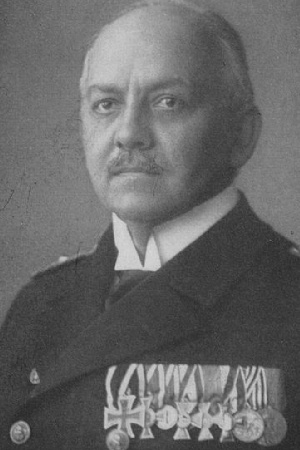
Fregattenkapitän
Max Looff
Reichsmarine 1928
Looff was
commander of the SMS Königsberg during the East
African Campaign of the First World War. In this
photograph he wears the uniform of the post-war
Reichsmarine. His medal bar shows the Prussian
Iron Cross second class (his first class is
presumably out of shot lower down his chest),
the next two medals are both the Prussian Life Saving Medal
showing he saved two lives. The second award is
more senior and is in the from of 4th class
cross of the Prussian Order of the Crown on the
ribbon of the Life Saving Medal, while the first
award is the standard life Saving medal. The
next medals are the Prussian Red Eagle fourth
class peacetime award, Prussian Officers Long
Service Cross, Hamburg Hanseatic Cross, China Campaign Medal
and the Prussian Wilhelm I Centenary Medal.
Later photographs of Looff show him wearing
several unexplained clasps on his China Campaign
Medal (see Medal Net).
Photo from Wikipedia originally printed in "Unsere
Marine im Weltkrieg 1914-18" by E Mantey
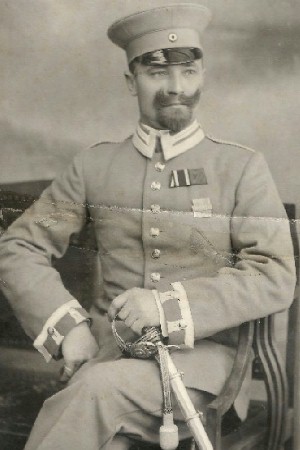
Vizefeldwebel Buschan
South West African Schutztruppe NCO 1906
He wears a
Schutztruppe 1897 grey home uniform with ribbons for the
Prussian Military Honour Award Second Class and the Wilhelm
I Centenary Medal (the yellow ribbon of which appears a
darker shade due to the orthochromatic photography of the
time) and below them, the Prussian Long Service Award for 21
years (although his colonial service would have counted
double towards his service years). Note that the ribbons are folded into Trapezoid shape as was
common prior to the First World War. Photo © Karsten Herzogenrath
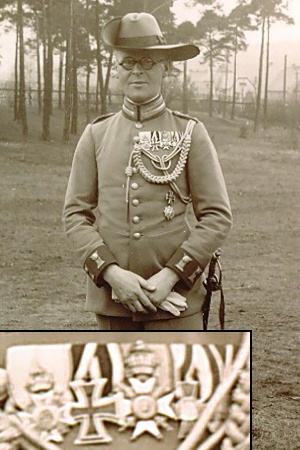
Hauptmann von Loßnitzer
formerly of the South West African Schutztruppe
1933
He wears a Schutztruppe 1897
grey home uniform with the Südwester hat. His medal bar
shows the Saxon
Knights Cross of St Henry, followed by the Iron Cross second class
(note that as a proud Saxon
wears his Saxon medal ahead of the Prussian one), the Saxe-Ernestine Knights Cross first class with
swords, the Hamburg Hanseatic Cross and another unidentified
medal that may be a semi-official colonial commemorative medal. Below the
medal bar he wears the Prussian Iron Cross, first class
and the post-war Lion Order.
Photo © Christophe Deruelle
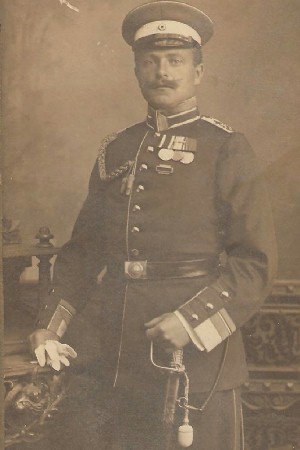
Feldwebel of the II.
Seebataillon
He wears the dark blue home uniform with peaked cap. His sword and
double rank lace on the cuffs show him to be a Feldwebel. He wears
a marksmanship lanyard on the right chest and several medals on the
left- the Prussian Military Honour Award, the South West African Medal
with clasp, the Prussian Wilhelm I Centenary Medal and below it the
Prussian other ranks Long Service Award third class.
Photo © Peter Klein
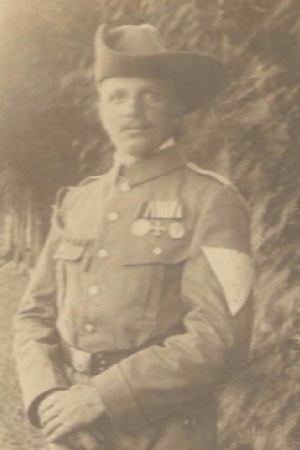
South
West African Schutztruppe NCO
He wears an 1896 Schutztruppe khaki uniform piped
in blue with a Südwester hat also piped in blue. Note
the arm chevrons of a Feldwebel. On his left
breast he wears three medals, the Prussian Military
Honour Award, second class, the Prussian Long Service
Award, first class and the South-West-Africa Campaign
Medal. On his right
breast he wears a marksmanship lanyard in the imperial
colours.
Photo © Peter Klein
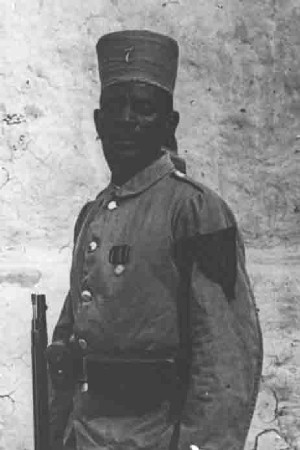
Askari Feldwebel ("Sol")
7. FK East African Schutztruppe cMid 1890s
He wears the khaki uniform with Tarbush. Note the company number showing him
to be from the 7. Feldkompagnie based at Bukoba and the four large rank
chevrons. On his left breast he wears the German Warriors Merit Medal for
African troops.
Photo ©
Frankfurt University Koloniales Bildarchiv
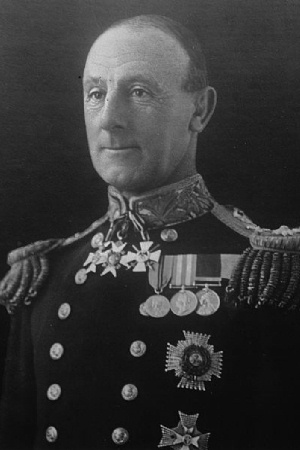
Admiral John Jellicoe
He wears the uniform of a British Royal
Navy officer with many decorations including the
Prussian Red Eagle second class with swords at his throat. This
medal was awarded for service as a Captain in China during
the Boxer Rebellion alongside the German and other allied
fleets. Jellicoe later commanded the British Grand
Fleet in 1916 at the Battle of Jutland against the German High Seas Fleet.
He did not wear this German award during the
First World War.
Photo from Wikimedia
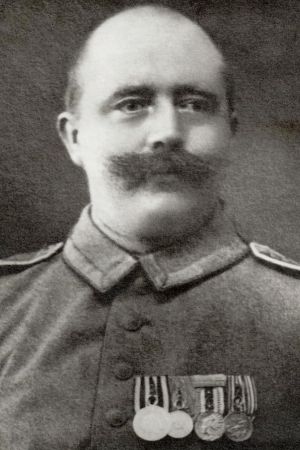
German Army Unteroffizier c1914-16
This NCO serving in Europe during the First World War
was a veteran of the Herero and Boxer Rebellions. He wears
the 1910 field grey uniform, note the shortened
NCO lace on the collar. On his breast is a medal
bar with the Prussian Military Honour Award second class, the Prussian
Long Service Award third class, the South West Africa medal
with a campaign clasp and the China medal.
Photo © JW Collection |